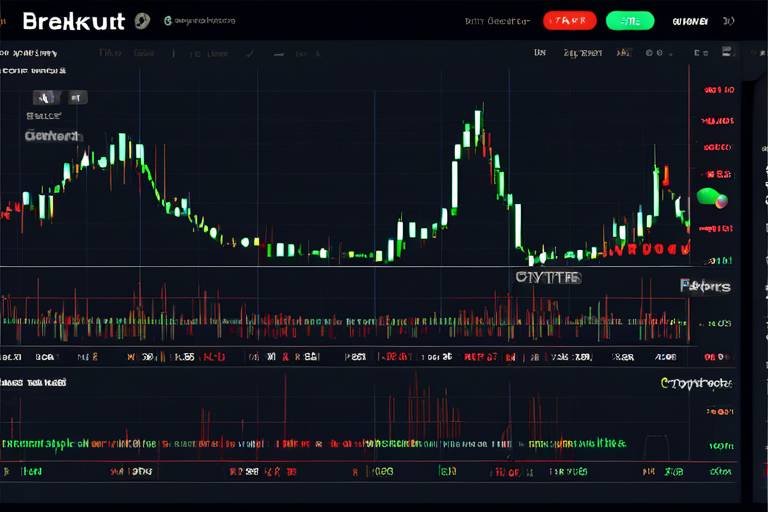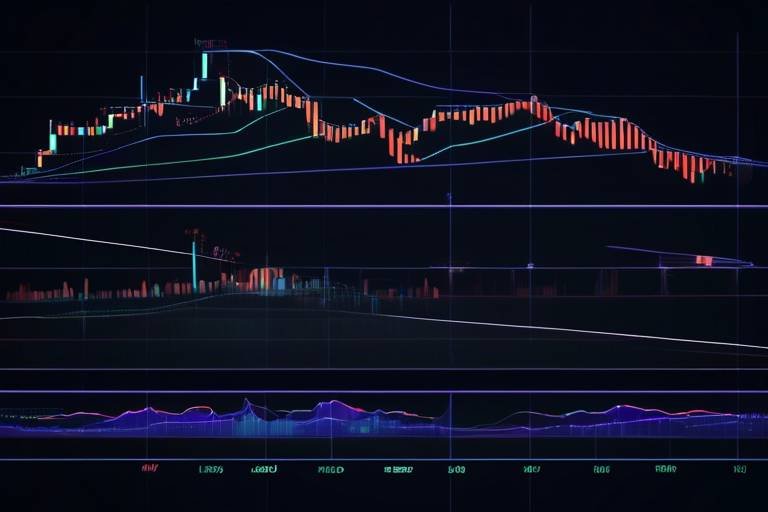Understanding the Role of Fibonacci Extensions in Trading
In the ever-evolving world of trading, making informed decisions can often feel like navigating a labyrinth. One tool that has gained popularity among traders for its predictive capabilities is Fibonacci extensions. These mathematical ratios, derived from the Fibonacci sequence, are not just numbers; they are like a compass guiding traders through the complexities of market movements. By understanding Fibonacci extensions, traders can enhance their decision-making process, identify potential price targets, and ultimately improve their overall market analysis.
Imagine you're on a road trip, and you have a map that shows not just your current location but also potential destinations based on your route. Fibonacci extensions serve a similar purpose in trading. They help traders look beyond the usual retracement levels and anticipate where prices might head next. This foresight can be invaluable, especially in volatile markets where every tick can mean profit or loss.
Moreover, Fibonacci extensions are often used in conjunction with other technical analysis tools, creating a more robust trading strategy. For instance, when combined with moving averages or momentum indicators, Fibonacci levels can provide traders with a clearer picture of potential entry and exit points. This integration is crucial because relying solely on one tool can lead to a skewed perspective of the market.
As we delve deeper into the intricacies of Fibonacci extensions, we will explore how to calculate them, identify key levels, and apply them practically in different trading scenarios. We will also discuss common mistakes traders make when using these extensions and how to avoid them, ensuring that you are well-equipped to maximize your trading strategy.
- What are Fibonacci extensions used for? Fibonacci extensions are used to forecast potential price movements beyond standard retracement levels, helping traders identify future support and resistance.
- How do I calculate Fibonacci extensions? To calculate Fibonacci extensions, you typically identify a significant price movement and apply the Fibonacci ratios (like 161.8%, 261.8%, etc.) to project future price levels.
- Can Fibonacci extensions be used in any market? Yes, Fibonacci extensions can be applied in various markets, including stocks, forex, and commodities, making them a versatile tool for traders.

What are Fibonacci Extensions?
Fibonacci extensions are essential tools in the realm of technical analysis, primarily used by traders to forecast potential price movements that go beyond the standard retracement levels. If you're familiar with the Fibonacci sequence, you know that it’s a series of numbers where each number is the sum of the two preceding ones. This sequence is not just a mathematical curiosity; it has profound implications in the world of finance and trading.
When traders apply Fibonacci extensions, they aim to identify future support and resistance levels. Unlike retracement levels, which help in understanding temporary reversals during a trend, extensions push the boundaries further, allowing traders to set ambitious price targets. The most commonly used Fibonacci extension levels are 161.8%, 261.8%, and 423.6%. These levels can act as potential price targets where the market might reverse or consolidate.
To visualize how Fibonacci extensions work, consider this analogy: imagine you're climbing a mountain. The base of the mountain represents the starting price, while the peak represents the target price. Fibonacci extensions are like markers along the way that help you navigate the terrain beyond the peak, guiding you on how far you might go after reaching your initial summit.
For instance, if a stock has recently surged from $50 to $100, the Fibonacci extension levels can help identify where the price might head next after a pullback. By applying these levels, traders can make more informed decisions about when to enter or exit trades, thereby enhancing their overall trading strategy.
Incorporating Fibonacci extensions into your trading toolkit is not just about identifying numbers; it's about understanding the psychology of the market. Traders often react to these levels, which can create self-fulfilling prophecies. When enough traders believe that a certain price level will act as resistance, it often does, simply because of the collective belief in that level.
In summary, Fibonacci extensions are powerful tools that help traders identify potential price targets beyond traditional levels, providing a strategic advantage in the fast-paced world of trading. By understanding these extensions, traders can enhance their decision-making processes and navigate market movements with greater confidence.

How to Calculate Fibonacci Extensions
Calculating Fibonacci extensions might seem daunting at first, but once you get the hang of it, you’ll find it to be a powerful tool in your trading arsenal. The process revolves around the Fibonacci sequence, which is a series of numbers where each number is the sum of the two preceding ones. In trading, we use specific ratios derived from this sequence—namely 161.8%, 261.8%, and 423.6%—to project potential price movements beyond traditional retracement levels.
To start calculating Fibonacci extensions, follow these simple steps:
- Identify the Trend: Determine whether you are in an uptrend or downtrend. This is crucial because the calculation will differ based on the trend direction.
- Select the Swing Points: For an uptrend, choose the most recent significant low and high points. Conversely, for a downtrend, select the recent high and low points.
- Measure the Price Movement: Calculate the distance between the selected swing points. This distance will serve as the basis for your extensions.
- Apply the Fibonacci Ratios: Multiply the price movement by the Fibonacci ratios (161.8%, 261.8%, and 423.6%) and add these values to the high point (for an uptrend) or subtract from the low point (for a downtrend) to find the extension levels.
Here’s a quick example to illustrate this:
| Step | Description | Calculation |
|---|---|---|
| 1 | Identify the swing low at $50 and swing high at $100. | - |
| 2 | Calculate the price movement: $100 - $50 $50. | $100 - $50 $50 |
| 3 | Apply the Fibonacci ratios: | - |
| 4 | 161.8% extension: $100 + ($50 * 1.618) $180.90. | $100 + $80.90 $180.90 |
| 5 | 261.8% extension: $100 + ($50 * 2.618) $230.90. | $100 + $130.90 $230.90 |
Once you have calculated these extension levels, you can use them to set potential price targets for your trades. The levels you derive will serve as crucial indicators for where the price might move next, allowing you to make informed decisions about entering or exiting trades.
Keep in mind that while Fibonacci extensions can provide valuable insights, they are not foolproof. It’s essential to combine them with other indicators and market analysis techniques to create a robust trading strategy. By understanding how to calculate and apply Fibonacci extensions, you’ll be better equipped to navigate the complexities of the market and enhance your trading performance.
- What is the main purpose of Fibonacci extensions? Fibonacci extensions help traders identify potential price targets beyond the usual retracement levels, enhancing decision-making.
- Can Fibonacci extensions be used in all trading styles? Yes, they can be applied in various trading styles, including day trading, swing trading, and long-term investing.
- Are Fibonacci extensions reliable? While they can be useful, they should not be the sole basis for trading decisions. It's best to use them in conjunction with other technical indicators.

Identifying Key Levels
Identifying key levels in Fibonacci extensions is akin to finding the North Star on a cloudy night; it guides traders through the murky waters of the market. These levels stem from significant price movements, which serve as the foundation for understanding where the market might head next. But how do you pinpoint these crucial levels? It’s all about analyzing past price action and recognizing the patterns that emerge.
To start, traders typically look for major swing highs and swing lows on a price chart. These points act as anchors from which Fibonacci levels can be projected. Once you have identified these swings, you can apply the Fibonacci extension tool to calculate potential future price targets. The most common extension levels to watch for are 161.8%, 261.8%, and 423.6%. Each of these levels can serve as a potential resistance or support point, depending on the direction of the market movement.
Moreover, it’s essential to consider the context of the market when identifying these key levels. For instance, if a stock has been in a strong uptrend, the Fibonacci extension levels above the recent high can indicate potential price targets for taking profits. Conversely, in a downtrend, these levels can help identify where the price might find support. This duality is what makes Fibonacci extensions so powerful.
Additionally, it’s beneficial to integrate Fibonacci levels with other technical indicators to enhance their reliability. For example, if a Fibonacci extension level coincides with a moving average or a trendline, it can reinforce the significance of that level. This confluence of indicators can be a strong signal for traders, providing a clearer picture of market dynamics.
In summary, identifying key levels using Fibonacci extensions requires an understanding of price action, market context, and the integration of various technical indicators. By honing this skill, traders can set realistic price targets, making their trading strategies more robust and effective.
- What are Fibonacci extensions used for in trading?
Fibonacci extensions are used to predict potential price movements beyond standard retracement levels, helping traders identify future support and resistance levels. - How do I calculate Fibonacci extensions?
To calculate Fibonacci extensions, identify significant swing highs and lows, then apply the Fibonacci extension tool to project potential price targets based on the Fibonacci sequence. - Can Fibonacci extensions be used with other indicators?
Yes, combining Fibonacci extensions with other technical indicators, such as moving averages or trendlines, can provide a more comprehensive view of market conditions and enhance trading strategies. - What are common mistakes to avoid with Fibonacci extensions?
Common mistakes include over-reliance on Fibonacci levels without considering market context and ignoring market sentiment, which can lead to poor trading decisions.

Using Historical Data
When it comes to trading, historical data is like a treasure map that guides you through the unpredictable landscape of the market. By examining past price movements, traders can gain valuable insights into potential future behavior. This is where Fibonacci extensions come into play, as they rely heavily on historical price action to identify key levels that could influence market dynamics.
To effectively use historical data in conjunction with Fibonacci extensions, traders should focus on several crucial aspects:
- Trend Analysis: Look for significant trends in historical data. Were there consistent upward or downward movements? Identifying these trends helps in understanding where Fibonacci levels might be relevant.
- Price Patterns: Analyze recurring price patterns, such as head and shoulders or double tops/bottoms. These patterns can indicate potential reversal points that align with Fibonacci extension levels.
- Volume Analysis: Historical volume data can provide context to price movements. High trading volume at certain price levels can reinforce the strength of Fibonacci extensions as support or resistance.
To illustrate how historical data can enhance the effectiveness of Fibonacci extensions, consider the following table that summarizes key historical events and their corresponding Fibonacci levels:
| Event | Date | Fibonacci Level | Price Reaction |
|---|---|---|---|
| Market Rally | Jan 2022 | 161.8% | Price hit resistance, then retraced. |
| Market Correction | Mar 2022 | 261.8% | Price found support and bounced back. |
| Breakout | May 2022 | 423.6% | Price surged past the level, indicating strong momentum. |
By analyzing historical data, traders can not only validate the significance of Fibonacci extension levels but also refine their entry and exit strategies. Remember, the past is not just a series of numbers; it's a reflection of market psychology, and understanding this can lead to more informed trading decisions.

Integration with Other Indicators
When it comes to trading, relying solely on Fibonacci extensions can be like trying to navigate a ship without a compass. While these extensions provide valuable insights into potential price targets, integrating them with other technical indicators can significantly enhance your trading strategy. Think of it as creating a well-rounded meal; each ingredient adds flavor and depth to the dish, making it more satisfying and complete.
For instance, combining Fibonacci extensions with moving averages can help you identify the overall trend direction. If the price is approaching a Fibonacci extension level and is also near a moving average, it may indicate a stronger potential reversal or continuation point. This dual confirmation can bolster your confidence in making trading decisions.
Another powerful combination is using Fibonacci extensions alongside Relative Strength Index (RSI). The RSI helps gauge whether a market is overbought or oversold. If the RSI indicates that a market is overbought at a Fibonacci extension level, it can signal a potential price reversal, providing traders with a more robust framework for decision-making.
Moreover, integrating Fibonacci extensions with candlestick patterns can offer additional context. For example, if a bullish engulfing pattern forms at a key Fibonacci extension level, it may suggest a strong buying opportunity. This synergy between different indicators can create a clearer picture of market dynamics, helping traders make more informed choices.
To illustrate the effectiveness of these combinations, here’s a simple table summarizing how different indicators can work with Fibonacci extensions:
| Indicator | Purpose | How it Complements Fibonacci Extensions |
|---|---|---|
| Moving Averages | Trend Direction | Confirms potential reversal or continuation at Fibonacci levels. |
| Relative Strength Index (RSI) | Market Overbought/Oversold | Signals potential reversals when combined with Fibonacci levels. |
| Candlestick Patterns | Market Sentiment | Provides context for price action at Fibonacci levels. |
In summary, integrating Fibonacci extensions with other technical indicators can transform your trading approach from basic to advanced. By considering multiple perspectives, you can better navigate the complexities of the market, leading to more successful trades. Just remember, the key is to use these tools in harmony, allowing each to enhance the other, rather than relying on any single indicator to dictate your trading decisions.
- What are Fibonacci extensions used for in trading?
Fibonacci extensions are used to predict potential price movements beyond standard retracement levels, helping traders identify future support and resistance levels. - How do I calculate Fibonacci extensions?
To calculate Fibonacci extensions, you first identify a significant price movement and then apply the Fibonacci ratios (such as 161.8%, 261.8%, etc.) to determine potential future price levels. - Can Fibonacci extensions be used in all trading styles?
Yes, Fibonacci extensions can be applied in various trading styles, including day trading and swing trading, to capitalize on market trends. - What are some common mistakes when using Fibonacci extensions?
Common mistakes include miscalculating levels, over-relying on them without considering other market factors, and ignoring market sentiment.

Practical Applications in Trading
When it comes to trading, understanding Fibonacci extensions can be a game-changer. These tools are not just theoretical concepts; they have practical applications that traders can leverage to enhance their strategies. For instance, in swing trading, Fibonacci extensions can help traders identify potential price targets after a significant price movement. By identifying these levels, traders can set realistic profit-taking points that align with market behavior. Imagine standing on the edge of a diving board, knowing exactly where the water will be when you jump—this is what Fibonacci extensions can do for your trading decisions.
In the realm of day trading, the speed and accuracy of your decisions are crucial. Fibonacci extensions can serve as a quick reference for potential price targets during the day. For example, if a stock has recently surged, a trader can use Fibonacci levels to predict where the price might retrace or extend. This allows for timely entries and exits, maximizing profits while minimizing risks. Think of it as having a GPS system that not only tells you where to go but also helps you navigate through unexpected roadblocks.
Moreover, Fibonacci extensions can be particularly useful in identifying support and resistance levels. These levels act like invisible barriers in the market. When a price approaches a Fibonacci extension level, it can either bounce back or break through, providing traders with critical insights into market sentiment. By combining these levels with other technical indicators, such as moving averages or RSI (Relative Strength Index), traders can create a more robust trading strategy. It's like having a multi-tool in your pocket—each tool serves a different purpose, but together, they make you more effective.
To illustrate the practical applications further, let's look at a hypothetical scenario. Suppose a trader identifies a significant upward movement in a stock price, climbing from $50 to $100. By applying Fibonacci extensions, the trader can calculate potential target levels at 161.8% and 261.8% of the original movement. This means the trader might set profit targets at $161.80 and $261.80. If the stock begins to pull back, knowing these levels can help the trader decide whether to hold, sell, or buy more shares. The key is to remain flexible and responsive to market changes while keeping these levels in mind.
In summary, incorporating Fibonacci extensions into trading strategies is not just about numbers; it's about understanding market dynamics and making informed decisions. Whether you are a swing trader looking to capitalize on larger price movements or a day trader seeking quick profits, these extensions provide valuable insights that can enhance your trading experience. Remember, the goal is not just to predict the future but to prepare for it, and Fibonacci extensions can be a vital part of that preparation.
- What are Fibonacci extensions?
Fibonacci extensions are tools used in technical analysis to predict potential price movements beyond standard retracement levels. - How do I calculate Fibonacci extensions?
To calculate Fibonacci extensions, you identify a significant price movement, then apply Fibonacci ratios (such as 161.8% and 261.8%) to project future price levels. - Can Fibonacci extensions be used in all trading styles?
Yes, they can be applied in various trading styles, including swing trading and day trading, to help identify potential price targets. - What are common mistakes to avoid when using Fibonacci extensions?
Common mistakes include miscalculating levels and over-relying on extensions without considering market context or sentiment.

Common Mistakes to Avoid
When it comes to trading with Fibonacci extensions, even seasoned traders can fall into traps that can lead to costly mistakes. One of the most significant errors is miscalculating Fibonacci levels. This can happen when traders do not accurately identify the high and low points of a price movement. For instance, if you mistakenly select the wrong points, the extension levels you derive will be off, leading to misguided trading decisions. It’s essential to double-check your calculations and ensure that you are using the most relevant price swings.
Another common pitfall is the over-reliance on Fibonacci extensions. While these tools can provide valuable insights, they should never be the sole basis for your trading strategy. Think of Fibonacci extensions like a compass; they can guide you, but they don’t replace the need for a map. Ignoring other market indicators, such as trend lines or moving averages, can create a skewed perspective of market conditions. Always remember to integrate Fibonacci analysis with a broader technical analysis framework.
Moreover, ignoring market sentiment can be detrimental. Market psychology plays a crucial role in price movements, and relying solely on Fibonacci levels without considering the prevailing market sentiment is like sailing a ship without checking the weather. For example, if the market is bearish despite your Fibonacci levels indicating a bullish move, it’s wise to reconsider your strategy. Understanding the emotional state of the market can provide context that pure technical analysis might miss.
In addition to these mistakes, many traders also fail to adapt their Fibonacci extension strategies to different market conditions. What works in a trending market may not be effective in a range-bound market. It’s crucial to be flexible and adjust your approach based on the current market environment. This adaptability can mean the difference between a successful trade and a costly mistake.
To sum up, avoiding these common mistakes requires a combination of accuracy, awareness, and adaptability. By being mindful of your calculations, integrating other indicators, considering market sentiment, and adjusting your strategies to fit the market conditions, you can significantly enhance your trading proficiency. Remember, trading is not just about numbers; it’s about understanding the story they tell and acting wisely.
- What are Fibonacci extensions?
Fibonacci extensions are tools used in technical analysis to predict potential price movements beyond standard retracement levels, helping traders identify future support and resistance levels.
- How do I calculate Fibonacci extensions?
To calculate Fibonacci extensions, identify the significant price swing high and low, then apply the Fibonacci ratios (typically 161.8%, 261.8%, and 423.6%) to project potential price targets.
- Can Fibonacci extensions be used in any market?
Yes, Fibonacci extensions can be applied across various markets, including stocks, forex, and commodities. However, their effectiveness may vary based on market conditions.
- Should I rely solely on Fibonacci extensions for trading?
No, while Fibonacci extensions are valuable, they should be used in conjunction with other technical indicators and market analysis for a more comprehensive trading strategy.
- How can I avoid common mistakes when using Fibonacci extensions?
To avoid mistakes, ensure accurate calculations, consider market sentiment, and adapt your strategies to current market conditions. Always use Fibonacci extensions as part of a broader trading framework.

Over-Reliance on Extensions
When it comes to trading, many traders fall into the trap of over-relying on Fibonacci extensions. It's almost like wearing blinders; while these tools can provide valuable insights, they shouldn't be the sole focus of your trading strategy. Think of Fibonacci extensions as a compass—they can guide you, but they don't replace the need for a complete map of the market.
One of the biggest mistakes traders make is assuming that Fibonacci extensions will always accurately predict price movements. While they can indicate potential price targets, the market is influenced by a multitude of factors, including economic news, geopolitical events, and overall market sentiment. Ignoring these elements can lead to misguided decisions. For instance, if a trader sees a Fibonacci extension level and decides to enter a trade without considering current market conditions, they might find themselves on the wrong side of a price swing.
Moreover, relying solely on Fibonacci extensions can create a false sense of security. Just because a level appears strong on the chart doesn't mean it will hold in the real world. Market dynamics are fluid, and prices can break through these levels due to unexpected news or changes in trader sentiment. Therefore, it's essential to use Fibonacci extensions in conjunction with other technical indicators, such as moving averages or momentum indicators, to create a well-rounded trading strategy.
To illustrate the importance of a balanced approach, consider the following table that compares the effectiveness of using Fibonacci extensions alone versus a combination of tools:
| Trading Approach | Pros | Cons |
|---|---|---|
| Fibonacci Extensions Only | Simple to use, easy to identify levels | Ignores market context, prone to false signals |
| Fibonacci Extensions + Other Indicators | More comprehensive analysis, better decision-making | Requires more knowledge and analysis |
In conclusion, while Fibonacci extensions are a powerful tool in trading, they should never be used in isolation. By integrating them with other indicators and considering market sentiment, traders can make more informed decisions and avoid the pitfalls of over-reliance. Always remember, the market is a complex organism, and successful trading requires a holistic approach.
- What are Fibonacci extensions used for in trading?
Fibonacci extensions help traders identify potential price targets beyond standard retracement levels, assisting in decision-making. - Can I rely solely on Fibonacci extensions for trading?
No, it's essential to combine Fibonacci extensions with other indicators and market analysis for a comprehensive trading strategy. - How do I calculate Fibonacci extensions?
Fibonacci extensions are calculated based on the Fibonacci sequence and significant price movements. Specific steps can help you determine these levels accurately. - What common mistakes should I avoid with Fibonacci extensions?
Avoid over-reliance on extensions, ignoring market sentiment, and miscalculating levels to improve your trading outcomes.

Ignoring Market Sentiment
When it comes to trading, many traders often find themselves caught up in the technical aspects, such as Fibonacci extensions, without considering the underlying market sentiment. This oversight can be detrimental to their trading success. Market sentiment refers to the overall attitude or feeling of investors toward a particular security or financial market. It is shaped by various factors, including news events, economic indicators, and even social media trends. Ignoring this sentiment is akin to sailing a ship without checking the weather; you might be heading in the right direction, but a sudden storm can throw you off course.
Understanding market sentiment is crucial because it can significantly influence price movements. For example, if the market sentiment is overwhelmingly bullish, even if a Fibonacci extension level suggests a potential resistance, prices may continue to rise as buyers flood the market. Conversely, in a bearish sentiment, prices may fall sharply, disregarding any support levels indicated by Fibonacci extensions. This is why it’s essential to integrate sentiment analysis into your trading strategy.
To better grasp how sentiment can impact your trading decisions, consider the following factors:
- News Events: Major announcements, such as earnings reports or economic data releases, can shift market sentiment rapidly.
- Market Trends: The prevailing trend can provide insights into the general sentiment. Are more traders buying or selling?
- Social Media Influence: Platforms like Twitter and Reddit can amplify sentiment, especially among retail investors.
Incorporating market sentiment into your analysis doesn't mean you should abandon Fibonacci extensions or other technical indicators. Instead, think of them as complementary tools. For instance, if a Fibonacci extension suggests a price target at a certain level, but the market sentiment is strongly negative, it might be wise to reconsider your position. A combination of technical analysis and sentiment analysis can create a more robust trading strategy, enhancing your ability to make informed decisions.
In summary, while Fibonacci extensions are valuable tools for predicting price movements, they should never be used in isolation. By acknowledging and analyzing market sentiment, traders can gain a more comprehensive view of the market landscape, ultimately leading to more successful trading outcomes. Remember, in the world of trading, it’s not just about the numbers; it’s also about understanding the emotions driving those numbers.
- What are Fibonacci extensions?
Fibonacci extensions are technical analysis tools used to predict potential price movements beyond standard retracement levels, helping traders identify future support and resistance levels.
- How do I calculate Fibonacci extensions?
To calculate Fibonacci extensions, identify a significant price movement, draw a Fibonacci retracement from the low to the high, and then extend the levels beyond the high using the Fibonacci ratios (e.g., 161.8%, 261.8%).
- Why is market sentiment important in trading?
Market sentiment can significantly influence price movements. Understanding it helps traders make more informed decisions and avoid potential pitfalls that arise from relying solely on technical indicators.
- Can I use Fibonacci extensions with other indicators?
Yes! Combining Fibonacci extensions with other technical indicators, such as moving averages or RSI, can provide a more comprehensive view of market conditions and improve your trading strategy.

Conclusion: Maximizing Your Trading Strategy
In the ever-evolving world of trading, leveraging Fibonacci extensions can be a game changer for traders looking to enhance their strategies. By effectively utilizing these tools, you can not only identify potential price targets but also improve your overall market analysis. The magic of Fibonacci lies in its ability to provide a structured approach to predicting price movements, allowing you to make informed decisions rather than relying solely on gut feelings.
However, it's crucial to remember that Fibonacci extensions should not be used in isolation. They are best employed as part of a comprehensive trading strategy that incorporates various technical indicators and an understanding of market sentiment. This holistic approach ensures that you are not just chasing numbers but are also considering the broader market context, which can significantly influence price dynamics.
To maximize your trading strategy, consider the following key points:
- Integrate with Other Indicators: Combine Fibonacci extensions with tools like moving averages or RSI to enhance your analysis.
- Stay Informed: Keep an eye on market news and trends that could impact price movements.
- Practice Risk Management: Always have a risk management plan in place to protect your capital.
By embracing these strategies, you can turn the powerful insights provided by Fibonacci extensions into actionable trading decisions. Remember, the goal is to create a well-rounded approach that not only focuses on potential price targets but also considers the current market landscape. With practice and a keen eye for detail, you can significantly boost your trading performance and profitability.
As traders delve into the world of Fibonacci extensions, several questions often arise. Here are some of the most commonly asked questions:
- What are Fibonacci extensions used for? Fibonacci extensions help traders identify potential price levels beyond standard retracement levels, indicating where the price might move after a retracement.
- How do I calculate Fibonacci extensions? To calculate Fibonacci extensions, identify a significant price movement, apply the Fibonacci ratios (like 161.8%, 261.8%, etc.), and project these levels beyond the high or low of the movement.
- Can Fibonacci extensions guarantee profits? While Fibonacci extensions can enhance your analysis, they do not guarantee profits. It's essential to combine them with other indicators and market analysis.
- What are the common mistakes when using Fibonacci extensions? Common mistakes include over-reliance on the tool, miscalculating levels, and ignoring market sentiment.
By addressing these questions and continually educating yourself, you can make the most of Fibonacci extensions in your trading journey. Remember, knowledge is power, and the more you understand the tools at your disposal, the better equipped you will be to navigate the complexities of the trading world.
Frequently Asked Questions
- What are Fibonacci extensions and how do they work?
Fibonacci extensions are powerful tools in technical analysis that help traders predict potential price movements beyond the usual retracement levels. By using the Fibonacci sequence, traders can identify future support and resistance levels, enhancing their decision-making process and market analysis.
- How do I calculate Fibonacci extensions correctly?
Calculating Fibonacci extensions involves a few straightforward steps. First, identify a significant price movement, then apply the Fibonacci ratios (such as 161.8%, 261.8%, and 423.6%) to find key price levels. This process allows traders to set realistic targets for their trades and manage risk effectively.
- Can I use Fibonacci extensions with other indicators?
Absolutely! Combining Fibonacci extensions with other technical indicators, like moving averages or RSI, can provide a more comprehensive view of market conditions. This integration can significantly improve the effectiveness of your trading strategies and lead to better-informed decisions.
- What are some common mistakes traders make with Fibonacci extensions?
One common mistake is over-relying on Fibonacci extensions without considering other market factors, which can lead to poor trading decisions. Additionally, ignoring market sentiment can result in missed opportunities or unnecessary losses. It's essential to use Fibonacci extensions as part of a broader trading strategy.
- How can historical data improve my use of Fibonacci extensions?
Analyzing historical price data can provide valuable insights into potential future movements. By looking at past trends, traders can enhance the accuracy of their Fibonacci extension levels, making their current trading decisions more informed and effective.



















